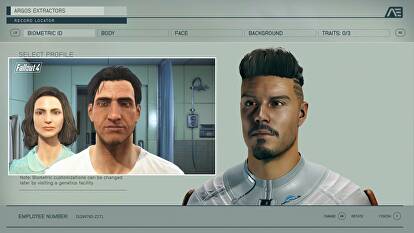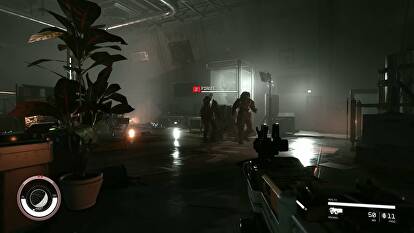Starfield: Fascinating new technology, but we can still see old problems here

It’s fair to say that Starfield is one of the most anticipated games. It is not difficult to understand why this is the case. Bethesda has built its empire with large-scale open-world role-playing games, despite all the mistakes it made in the process. There’s a reason why games like Skyrim remain so popular to this day. The carefully designed worlds and the feeling of freedom fire the imagination. On paper, Starfield feels like the logical conclusion, a game that expands beyond a single planet into the vastness of space. I figured it would be fun to dive into Bethesda’s presentation and see what we can find out about the game, from basic things like image quality and performance to the overall engineering and design concept.
Let’s start with the rendering resolution – the trailer is presented in native 4K resolution, but the footage varies in clarity of presentation. Interestingly, there doesn’t seem to be any anti-aliasing in the gameplay sequences, giving you consistently razor-sharp edges with visible aliasing. In contrast, the cutscenes use TAA in a manner similar to Fallout 4, which is more in line with what we’ll see in the final product.
Aside from the simple resolution, we can get a sense of the development team’s design goals by looking at how Starfield treats wide and open areas on the planets, interiors, character rendering, and finally outer space. For example, in an outdoor scene, we can see that the game casts shadows over long distances, which is crucial for preserving details at a distance. This is one of the main issues we’ve identified with Halo Infinite, and it’s great that Starfield has a fix.
Starfield also seems to have a system that shows localized fog in valleys, which looks great. In general, the atmospheric rendering seems quite robust from what we can see in this demo. The sky system is still unclear. It looks very promising, but due to the low bitrate of the trailer footage we had to watch, it’s hard to tell if it’s a proper volumetric system or just a simple skybox. Regardless, it delivers attractive results, we just have to see how dynamic it is in the finished game.
All of this is held together by the terrain system. It is likely that the planetary surfaces and structures were created using a combination of procedural generation and manually placed objects, which is a common approach these days. The terrain rendering itself is similar to previous Bethesda games, but pop-ins are kept to a minimum and detail can be seen well into the distance. The rendering capabilities, while attractive, don’t push the envelope – which is understandable given the game’s large scale and long development time.
Inside, things are different. Large area shadows that were low-resolution and grainy outdoors are sharply defined here. This section is reminiscent of Doom 3, with direct lights piercing the darkness while specular lights can be seen on the surfaces. Compared to Fallout 4, the jump in fidelity is significant as this game has rudimentary interior lighting and a distinct lack of textures and object detail.
This raises an interesting point: the lack of reflections. In the original teaser trailer, we saw almost RT-like reflections, but there’s no hint of screen-space reflections, let alone RT reflections, in any gameplay sequence. We see simple cube maps at best. In a setting that’s brimming with metallic surfaces, this strikes me as a little odd, screen-space reflections would greatly improve the look of the overall picture.
But there are also many positive elements here. The weapons, for example, look fantastic. I’ve never been a fan of the designs in Fallout 4 – the modeling and animation work left me cold – but Starfield is introducing weapons that look both stylish and powerful. Enemy animations are generally much better too. As an RPG, it still feels like draining a health bar rather than dealing direct damage, but the reactions are significantly better. The only thing missing is object related motion blur on weapons and enemies.
Character rendering has also improved significantly since Fallout 4, especially when you look past the character creation screens and instead focus on how they actually look in-game. The subsurface scattering, which is absent from all scenes, could improve things even further, accurately depicting how the light interacts with the surface of the skin. In the footage we’ve seen, it’s present on the ears but not on the rest of the skin, over-emphasizing the normal maps. Also, the geometry of the tear duct is a little too shiny and picks up the light so much that it almost seems to glow. Apart from these little things, however, the quality of the animations has improved significantly. Conversations in Fallout 4 had stiff and even ugly animations, while Starfield looks much more elegant in comparison.
The final major setting of Starfield is outer space. Although we only got a glimpse of it, the effects, such as laser blasts and explosions, are promising. It’s certainly a step up from the low-resolution smoke of landing on a planet. The big question I have about flying in space isn’t so much about the optics as it is about the possibilities. I would like to see the ship management involved in the voyage. Imagine being able to rise from the captain’s chair to explore the ship, managing both resources and systems. I think that could make the journey between planets more interesting and challenging. However, it’s unclear if this is an option or if the player simply controls the ship during flight.
There are a few other technical criticisms worth noting, such as the game’s indirect lighting. This has become an important topic in recent years and is key to realistic rendering – simulating the phenomenon of photons bouncing off a surface and indirectly illuminating another area. The problem right now is that areas that aren’t directly lit in Starfield have a uniform grayish color that doesn’t match the lighting results one would expect. Raytracing Global Illumination would work well here, but comes at a significant performance cost. A pre-rendered offline solution using probes might also work, but with so many planets the GI data would probably be way too large. This is a difficult problem to solve when developing a game of this scale.

And then there’s the performance. The trailer footage we have was container encoded at 30 fps, which limits the amount of analysis we can perform. However, there still seem to be issues worth emphasizing, such as the fact that all gameplay footage shows significant drops in performance, regularly dropping below 30fps. That’s not unusual for a game at this stage of development, but Bethesda’s track record in console releases has me wondering. This is the most noticeable flaw in the presentation and I hope the performance will improve before release, but we’ll have to wait and have tea.
The other aspect that intrigues me concerns the cities. In previous Bethesda releases, larger cities were typically divided by loading screens, while smaller cities were seamless. So can you land on a planet and make your way to a big city without loading screens? I hope we will find out soon.
Despite my criticisms, Starfield is Bethesda’s most compelling game to date. Most of the ugly bits that plagued Fallout 4 and 76 have been removed and there are beautiful environments to explore in their place. Starfield also shows structures and scale unlike anything they’ve created in the past. This whole 1,000 planets feature seemed ridiculous at first, but as you can imagine the key planets have been expanded and carefully designed while the rest can rely more on procedural generation. If the game structure supports this properly, it could be intriguing. Even as someone who’s largely burned out at open-world games, I’m very intrigued by Starfield.
All of this also means that Starfield will be a difficult game to analyze when it comes out next year – but I look forward to the challenge.
Originally written by John Linneman, Senior Staff Writer, Digital Foundry
Reference-www.eurogamer.de